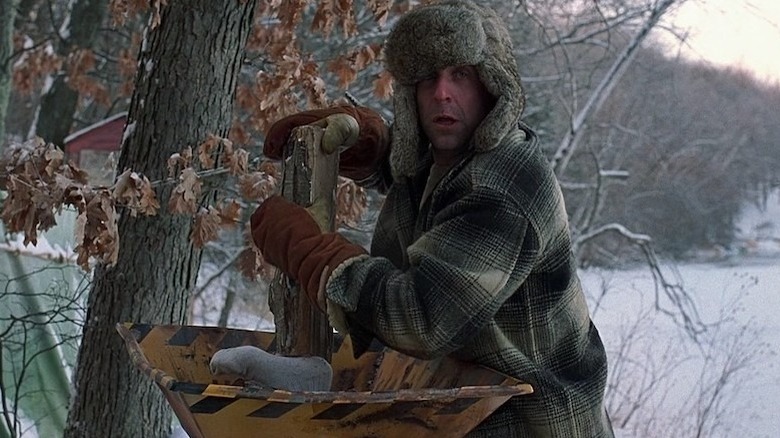Is Fargo Based On A True Story?
The 1996 Coen Brothers classic "Fargo" infamously opens with a card explaining that the film is based on a true story and "At the request of the survivors, the names have been changed. Out of respect for the dead, the rest has been told exactly as it occurred." By doing this, the directors instantly grabbed the audience's attention — especially when it comes to the more violent parts of the film, like the iconic wood chipper scene. And although most films that use the 'based on a true story' opening card usually exploit the real events with the glitz and glamor of Hollywood, "Fargo" really has pulled from reality. Sort of.
However, the FX "Fargo" TV series is pretty much completely fictional. As E! Online noted back in 2014, series creator Noah Hawley confessed that the series isn't based on any real cases, saying "I can't speak to the movie. But the show...It's all just made up. The whole cloth." He also pointed out that he didn't search for any sensational real criminal cases for inspiration, adding "I didn't go looking for true crime. It started from a character standpoint and everything grew organically out of that."
However, Hawley's series leans into the very intention of the "Fargo" film by the Coen Brothers. When speaking to Huff Post in 2016, Ethan Coen explained the reason behind the "true story" card which opened the 1996 crime thriller: "We wanted to make a movie just in the genre of a true story movie. You don't have to have a true story to make a true story movie." But was Jerry Lundegaard (William H. Macy) a real person? Did he really pay Carl Showalter (Steve Buscemi) and Gaear Grimsrud (Peter Stormare) to kidnap his wife?
Fargo was inspired by true events
Based on a true story? Maybe "inspired by true events" might've been a more honest opening card for "Fargo." Certain parts of the film were taken from real life cases, but only in the most general way possible. Joel Coen revealed to Huff Post the parts which really happened — like the car fraud in the film — saying "there was a guy, I believe in the '60s or '70s, who was gumming up serial numbers for cars and defrauding the General Motors Finance Corporation." Although he noted the case didn't get violent as it does in "Fargo," explaining that "There was no kidnapping. There was no murder. It was a guy defrauding the GM Finance Corporation at some point."
Clearly the Coens took this fraudulent case from the 1960s or 1970s and applied it to William H. Macy's character, Jerry Lundegaard. But what about that wood chipper scene? Well, as Joel Coen pointed out in the same interview; "There was a murder in Connecticut, where a man killed his wife and disposed of the body — put her into a wood chipper." He added "But beyond that, the story is made up."
It's taken from the murder of flight attendant Helle Crafts in 1986, who was killed by her husband Richard Crafts. He supposedly hit his wife over the head twice before freezing her body and dismembering it — later feeding the pieces through a wood chipper to further get rid of the evidence. Richard served 30 years of his original 50 year sentence and was released in 2020. So is "Fargo" based on a true story? Yes and no. With one foot in reality and one foot in fiction, the classic film and the brilliant FX series have created a pretty unique legacy.

